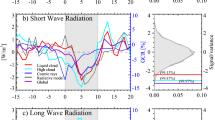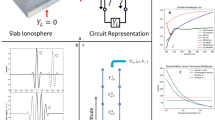Abstract
IN the E-layer of the ionosphere, the variations in the critical frequency (ƒ) depend mainly on the solar zenith angle (χ) and the phase of the cycle of solar activity. If solar activity is assumed to remain constant, the annual variation in ƒ at local noon can be represented by :  and the hour-to-hour variation during the day by :
and the hour-to-hour variation during the day by :  In these equations, ƒa and ƒd are assumed to be constant; the suffixes tand 12 denote the values of ƒ and χ at time t and at local noon, respectively. For a simple Chapman layer, m = n = 0.25, but Nicolet and Bossy1 have shown that, under certain conditions, m and n may differ from this value. Since the parameters ƒa and ƒd both correspond to χ = 0, they are sometimes referred to as the critical frequency at the ‘sub-solar point’. This terminology is misleading because it suggests that they should be equal to each other and also to the value of the actual critical frequency (ƒ0) at the geographical location where χ = 0. In fact, each of the parameters ƒa and ƒd represents the value of ƒ which results from the extrapolation of a series of measured values to a hypothetical condition χ = 0 ; they are not equal because different sets of data must necessarily be used in performing the two extrapolations and neither ƒa and ƒd is equal to ƒ0 except where the Sun is overhead at noon. By combining equations (1) and (2), it is easily shown that the relation between ƒa and ƒd is given by :
In these equations, ƒa and ƒd are assumed to be constant; the suffixes tand 12 denote the values of ƒ and χ at time t and at local noon, respectively. For a simple Chapman layer, m = n = 0.25, but Nicolet and Bossy1 have shown that, under certain conditions, m and n may differ from this value. Since the parameters ƒa and ƒd both correspond to χ = 0, they are sometimes referred to as the critical frequency at the ‘sub-solar point’. This terminology is misleading because it suggests that they should be equal to each other and also to the value of the actual critical frequency (ƒ0) at the geographical location where χ = 0. In fact, each of the parameters ƒa and ƒd represents the value of ƒ which results from the extrapolation of a series of measured values to a hypothetical condition χ = 0 ; they are not equal because different sets of data must necessarily be used in performing the two extrapolations and neither ƒa and ƒd is equal to ƒ0 except where the Sun is overhead at noon. By combining equations (1) and (2), it is easily shown that the relation between ƒa and ƒd is given by :  This equation implies that ƒd and ƒa cannot both be constant as was previously assumed. It appears that no evidence has yet been published to prove that the observed values of the E-layer critical frequency vary in conformity with equation (3); but this can easily be verified by comparing E-layer data which have been published by Minnis and Bazzard2 and by Eyfrig3. It will be shown that, near the minimum of the solar cyele, ƒa is constant and ƒd varies with χ12.
This equation implies that ƒd and ƒa cannot both be constant as was previously assumed. It appears that no evidence has yet been published to prove that the observed values of the E-layer critical frequency vary in conformity with equation (3); but this can easily be verified by comparing E-layer data which have been published by Minnis and Bazzard2 and by Eyfrig3. It will be shown that, near the minimum of the solar cyele, ƒa is constant and ƒd varies with χ12.
This is a preview of subscription content, access via your institution
Access options
Subscribe to this journal
Receive 51 print issues and online access
$199.00 per year
only $3.90 per issue
Buy this article
- Purchase on Springer Link
- Instant access to full article PDF
Prices may be subject to local taxes which are calculated during checkout
Similar content being viewed by others
References
Nicolet, M., and Bossy, L., Ann. Geophys., 5, 275 (1949).
Minnis, C. M., and Bazzard, G. H., J. Atmos. Terr. Phys., 18, 306 (1960).
Eyfrig, R., Geofis Pura e Appl., 45, 179 (1960).
Minnis, C. M., Proc. Thirteenth Gen. Assem. U.R.S.I., 12, Pt. 3, 10 (1960).
Harnischmacher, E., C.R. Acad. Sci. Paris, 230, 1301 (1950); 240, 553 (1955).
Beynon, W. J. G., and Brown, G. M., J. Atmos. Terr. Phys., 14, 138 (1959).
Shimazaki, T., J. Rad. Res. Lab. Japan, 7, 95 (1960).
Eyfrig, R., Nature, 196, 758 (1962).
Author information
Authors and Affiliations
Rights and permissions
About this article
Cite this article
MINNIS, C. Annual Variations in E-Layer Ionization. Nature 202, 170–171 (1964). https://doi.org/10.1038/202170a0
Issue Date:
DOI: https://doi.org/10.1038/202170a0
This article is cited by
Comments
By submitting a comment you agree to abide by our Terms and Community Guidelines. If you find something abusive or that does not comply with our terms or guidelines please flag it as inappropriate.



